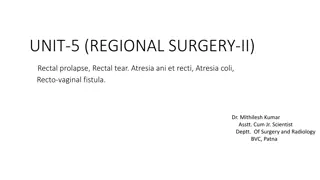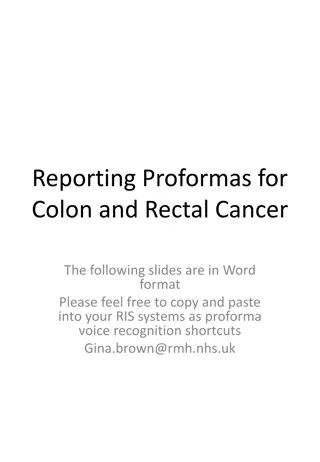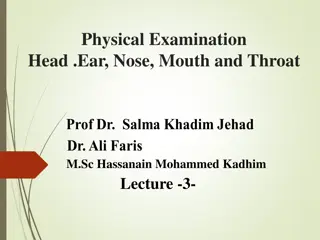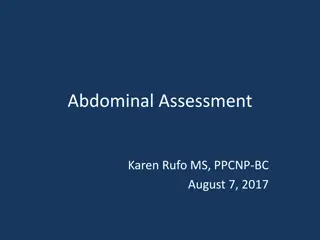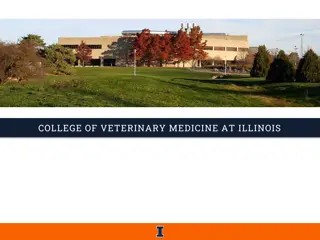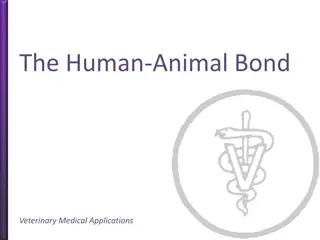Best Practices for Rectal Palpation in Veterinary Medicine
Rectal palpation is a crucial diagnostic method in veterinary medicine for assessing the reproductive health of animals like cows, buffaloes, mares, and camels. This technique helps in determining the normal and abnormal conditions of genital organs, aiding in pregnancy diagnosis and differentiating between healthy and diseased specimens. Proper restraint, clothing, precautions, and techniques are essential for a safe and effective rectal palpation procedure.
Download Presentation

Please find below an Image/Link to download the presentation.
The content on the website is provided AS IS for your information and personal use only. It may not be sold, licensed, or shared on other websites without obtaining consent from the author. Download presentation by click this link. If you encounter any issues during the download, it is possible that the publisher has removed the file from their server.
E N D
Presentation Transcript
Aims of rectal palpation To know the normal shape and size of different genital organs of different species which help in differentiating the normal and pathological specimen Per-rectal examination is the only practical diagnostic method permitting direct examination of genital organs of a cow, buffalo and mares. However in small animals organs are examined via abdominal palpation or by ultrasonography Rectal palpation is one of the important method for pregnancy diagnosis genital
Restraint and clothing The animal to be examined should be restraint The cow &buffalo: can securely restraint in chute When this is not available the hind legs should be tied Mares :are usually tied both hind lids with one fore leg using rope , twitch on lower lip,ears nose or lifting one fore leg Female camel: examined in sitting postion with both hind and fore legs tied together with rope The examiner must wear proper clothing and sufficient lubrication used before introducing the hand in rectum
Precaution during rectal palpation 1)Avoid palpation during peristaltic wave 2)Examiner must trim their nails and avoid using dirty soiled sleeves 3)Avoid rectal palpation without asleeve specially in mares to avoid contacting disease 4)Avoid rectal palpation of animal suffering from fever 5)Rectal palpation in buffalo must be gentle as the rectal mucosa is more fragile and bleed easily 6)Avoid un careful palpation of the uterine horn can cause rupture of the amniotic vescile and loss of an early pregnancy
Important fact:- The cervix which is ahard round to oval disfigured structure is the land mark.for location of genital structure in cattle & buffaloes. In the mare the cervix is not easily palpable and hence the ovaries are the land mark for rectal palpation.they are located about 5:10 Cm below the lumbar vertebrea in non pregnant &early pregnancy Feature of Genitalia of female camel is the shortness of the right uterine horn
PROCEDURE AND PRECAUTIONS: 1. Nails should be properly trimmed and rasped. 2. Finger rings, wrist-watch should be removed to avoid injury to rectal mucosa. 3. Wear protective clothings gloves and gumboots. 4. Apply lubricant over the glove. 5. Restrain the animal properly in a crate. 6. Hold the tail of animal resting on its back. 7. Clean the perineal and vulval region with water. 8. Lubricate the anal sphincter by putting index finger and dilate it. 9. Now put all fingers with index fingers making a cone shape of the hand and insert it for the examination.
10. Remove the faeces (back-racking) without removing the hand out of the rectum to avoid rectal ballooning by sucking of air in it. 11. If ballooning occurs, reduce it by gentle pinching the rectal floor at its anteriormost folds. 12. Do not examine during peristaltic wave of rectum and/ or when the animal is straining is present 13. Avoid force during examination. 14. Insert hand up to pelvic brim. 15. Locate the cervix as a firm tubular structure approximately 25cm from the anal sphincter.
16. Hold the cervix between thumb and index finger and examine its physio-pathological status including external os. 17. Examine the body of uterus which is in continuity of cervix. 18. Anterior to the body of uterus, there is false bifurcation of uterine horns attached with intercornual ligament. If needed, retract the organ for examination 19. Put middle or index finger between the two uterine horns and locate the intercornualligament 20. Palpate both the uterine horns one by one by digital pressure from base to tip to know the physio- pathological conditions like its symmetry, tonicity and for content (like pus) .)
21. Ovaries are located by the side of tubular organ-laterally almost near to the tip of uterine horn or at the level of uterine Bifurcation. 22. Hold the ovary between middle and index finger and palpate by thumb for presence or absence of functional structure over the ovary. 23. Fallopian tubes are normally not palpable except in pathological condition.
Palpation of uterus: Commonly used terms for characterizing uterine tone and condition of uterine tissue Estrus: tone - A turgid, contracted uterus that is often curled during palpation. Thickened (doughy) - A pathological condition, indicating thickning of the endometrium and myometrium. Fluctuant - Uterus with intraluminal fluid. Firmness - Chronic inflammation or neoplasia.
Palpation of ovary : Vesicles can be felt on the bovine ovary at all stages of the reproductive cycle. A vesicle with a thin wall, 1.5 cm. in diameter (sometimes up to 2.5 cm. diameter) and accompanied by pronounced contractibility of the uterus will be mature Graafian follicle of oestrus Mature Graafian follicle is frequently found towards the end of first half of the oestrouscycle i.e. first wave of follicle formation. At this stage either ovary also bears large corpus luteum, which is not usually present during oestrus.
Between the 2nd and 5th (6th) days of the cycle, there are neither vesicles nor solid structures (corpus luteum). This appearance can be confused with an inactive ovary. For this, re-examine the animal few days later. A small, soft, periodic corpus luteum can be felt from the 5th day of the cycle onwards. Most CL have a papilla or crown like projection or neck above the surface of the ovary. Corpus albicans are small and very firm structure which can be differentiated from fluctuating structure of Graafian follicles
Vaginal examination : Vaginoscope Aim : 1. Visualization for vagina. 2. Examination of vagina. 3. For certain case of infertility . 4. For collection of vaginal swab (for bact. Examination ) 5. Used with cervical technique with AI
Technique : Sterilization vaginoscope by firing . Lubricate vaginoscope by paraffin oil or vaslin . Take two vulval lips apart and insert vaginoscope firstly upward (to avoid suburetheral diverticulum & external uretheral orifice ) Then direct it forward and turn vaginoscopeand gradually open it to visualization , examination m.m and porchovaginalis .
Types : 1. Metalic . 2. Glass prespex 3. Vaginal opener
Finding : Mucous membrane of vagina : Rosy red color : during estrous ( normal ) Light red color : during diestrous Pale m.m : at under feeding anestrum Congested red m.m : in vaginitis Cervical mucous : At estrous : clear & transparent . At diestrous : dry mucous membrane In vaginitis : turbid or pus on m.m . Examination of : Acquired problems : as vaginitis , abscess or tumer . Conginital problems : as double porchovaginalis or flesh piller . Portiovaginalis: Opened: duning estrous. Closed: during diestrous. Rose shape: inflammation


